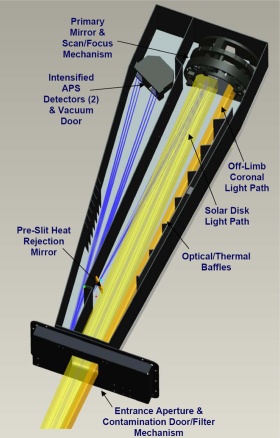|
SPICE - Spectral Imaging of the Coronal Environment
The extreme ultraviolet imaging spectrograph (EUS) of the Solar-Orbiter mission
The spectrograph SPICE is an extreme-ultraviolet imaging spectrograph presently under design for the Solar Orbiter mission. The SPICE spectrograph (Spectral Imaging of the Coronal Environment) was selected as a NASA contribution to Solar Orbiter (for the EUS instrument required in the model payload) under the PI-ship of Southwest Research Institute (SwRI, Boulder, USA). This instrument is designed to make observations in the far and extreme ultraviolet and will provide plasma diagnostics of the solar atmosphere where the temperature ranges from tens of thousands to several million degrees.
Science objectives
The Solar Orbiter provides due to its closeness to the Sun a unique platform for high-resolution solar observations, as well as observations of the Sun and its atmosphere out of the Sun-Earth line and ecliptic. The goals of the Solar Orbiter demand plasma diagnostic observations, made at high spatial, spectral and temporal resolution, of the solar atmosphere in the UV/EUV spectral range. The wavelength range of the spectrograph covers spectral emission lines from the chromosphere to the hot corona, i.e., from line-formation temperatures of thousands to several million degrees. SPICE will be the only instrument on Solar Orbiter, which can determine the properties of the coronal plasma by remote sensing, on the disk as well as through coronagraphic investigations above the limb. By this, SPICE will fill a critical gap in understanding the linkage between in-situ measurements of solar wind streams and their source region on the Sun.
Some specific examples of the scientific objectives of SPICE are:
-
Investigating the plasma state at and the relevant processes during the injection of material into the solar wind as well as the elemental composition in the low corona SPICE will address the question how and where the solar wind streams do originate.
-
The non-thermal line broadening and asymmetric line profiles that can be studied by SPICE in above-limb observations will allow us to tackle the problem of how the extended solar wind is accelerated and what role the ion-cyclotron process plays.
-
Analysing the injection of energetic particles during eruptive events will give access to the seed population of solar energetic particle (SEP) streams, especially during the co-rotation phases where the in-situ instruments will see the particles observed by SPICE in the source region. This allows addressing the question on how solar eruptions produce energetic particle radiation that fills the heliosphere and how solar transients drive heliospheric variability.
-
Above-limb observations will allow to investigate the plasma conditions at shock fronts, e.g. at the leading edge of coronal mass ejections (CMEs) in the inner corona and thus will enable answering the question where and how shocks are formed near the Sun.
-
Observations of flux ropes and current sheets in the corona prior and during their eruption in combination with the in-situ measurements of their propagation will allow addressing the question how the solar dynamo drives connections between the Sun and the heliosphere.
![[Top]](/images/icons/top.gif)
The Instrument
 The SPICE instrument is a high-resolution imaging spectrograph with a movable occulter to observe the solar corona both on the solar disk and off limb out to 3 solar radii. For outer coronal observations the occulter is used to reduce stray light by fully occulting the solar disk.
The SPICE instrument is a high-resolution imaging spectrograph with a movable occulter to observe the solar corona both on the solar disk and off limb out to 3 solar radii. For outer coronal observations the occulter is used to reduce stray light by fully occulting the solar disk.
To optimize throughput, the instrument consists of only two optical elements: a single off-axis parabolic telescope mirror and a toroidal variable line-spaced grating which re-images the spectrally dispersed radiation onto two array detectors. Two spectral passbands are recorded simultaneously with two intensified active pixel sensor (IAPS) detectors. The spectrograph will cover the extreme ultraviolet wavelength bands from 70.2 nm to 79.2 nm and from 97.2 nm to 105.0 nm (and 48.5 nm to 52.5 nm in 2nd order).
![[Top]](/images/icons/top.gif)
MPS contribution
MPS is actively participating in the design of the SPICE instrument. The main MPS contribution is the design and development of the primary telescope mirror. The primary mirror plays a key role in the optical and thermal design of the SPICE spectrograph. The off-axis mirror with a parabolic figure will have a novel reflective coating of boron carbide that will be efficient in the extreme ultraviolet but let the solar visible and thermal radiation pass largely unaffected. In this way the heat load on the mirror is reduced.
![[Top]](/images/icons/top.gif)
The Team
Dr. Werner Curdt, Prof. Dr. Eckart Marsch, Dr. Hardi Peter, Dr. Udo Schühle, Dr. Michael Kahle, Bianca Grauf
![[Top]](/images/icons/top.gif)
Related links
|
